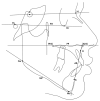Vertical Dentofacial Skeletal Divergency Is Not Linked with Oral Health-Related Quality of Life
- PMID: 38337358
- PMCID: PMC10856730
- DOI: 10.3390/jcm13030665
Vertical Dentofacial Skeletal Divergency Is Not Linked with Oral Health-Related Quality of Life
Abstract
The aim of this study is to assess how vertical skeletal malocclusion affects oral health-related quality of life (OHRQoL) among a sample of individuals comprising adolescents, young adults, and adults seeking orthodontic treatment. From January 2019 to March 2020, participants were consecutively enrolled. The assessment of OHRQoL involved measurement using the oral health impact profile (OHIP-14). Lateral cephalograms were performed to measure the vertical skeletal divergency with four cephalometric measurements. Descriptive and inferential statistical analyses were performed. The Mann-Whitney test was applied to compare OHRQoL scores according to the vertical dimension category. The mean age of the participants ranged between 30.3 ± 14.9 and 29.9 ± 14.4 and there was a majority of female participants, between 64.1% and 65.9%. There were no statistically significant differences observed between hyperdivergent and normodivergent groups in either the total score or any domain of the OHIP-14 questionnaire. Individuals with hyperdivergent facial morphology did not show a reduced OHRQoL compared with a normodivergent facial type.
Keywords: dentofacial skeletal divergency; malocclusion; oral health-related quality of life; orthodontic treatment.
Conflict of interest statement
The authors declare no conflicts of interest.
Figures
References
-
- Sun L., Wong H.M., McGrath C.P. Relationship between the severity of malocclusion and oral health related quality of life: A systematic review and meta-analysis. Oral Health Prev. Dent. 2017;16:503. - PubMed
-
- Göelzer J.G., Becker O.E., Junior O.L.H., Scolari N., Melo M.F.S., Heitz C., de Oliveira R.B. Assessing change in quality of life using the Oral Health Impact Profile (OHIP) in patients with different dentofacial deformities undergoing orthognathic surgery: A before and after comparison. Int. J. Oral Maxillofac. Surg. 2014;43:1353–1359. doi: 10.1016/j.ijom.2014.06.015. - DOI - PubMed
-
- Slade G.D., Spencer A.J. Development and evaluation of the Oral Health Impact Profile. Community Dent. Health. 1994;11:3–11. - PubMed
Grants and funding
LinkOut - more resources
Full Text Sources



